Paleolithic Cave Art Are Found in What Spanish Cave
| Cavern of Altamira and Paleolithic Cave Art of Northern Espana* | |
|---|---|
| UNESCO World Heritage Site | |
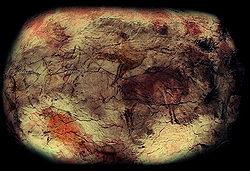 | |
| State Political party | Kingdom of spain |
| Type | Cultural |
| Criteria | i, 3 |
| Reference | 310 |
| Region** | Europe and North America |
| Inscription history | |
| Inscription | 1985 (9th Session) |
| Extensions | 2008 |
| * Name equally inscribed on World Heritage List. ** Region as classified by UNESCO. | |
Cave of Altamira and Paleolithic Cavern Art of Northern Espana is the proper noun under which 18 caves located in different regions of northern Espana are grouped together as a World Heritage Site. These caves are located in three autonomous regions: Cantabria, Asturias, and the Basque State. Altamira Cave was declared a World Heritage Site in 1985. In 2008 the site was expanded to include the 17 boosted caves. The caves comprise Paleolithic cave art dating from approximately 35,000 to 11,000 B.C.E. During this fourth dimension the first Homo Sapiens arrived in Northern Spain where they cohabited with the Neanderthals for a time. The primeval cave paintings were adult during this early on period of the Upper Paleolithic. During the latter years of this menstruum, known as the Magdalenian, a unique style of realistic portrayals developed in Cantabria. In 2012, a hand print and a red dot in the Cave of El Castillo were dated to an earlier period, at least 37,300 years and 40,800 years ago respectively, making these the oldest examples of cave fine art to exist discovered in Europe, several chiliad years older than those in Chauvet Cavern.
Contents
- i Cave of Altamira
- 2 Cantabria
- two.1 Cave of Chufín
- 2.2 Cave of Hornos de la Peña
- 2.3 Cave of El Pendo
- ii.4 Cavern of La Garma
- 2.5 Cave of Covalanas
- two.6 Complex of the Caves del Monte Castillo
- 2.6.1 Cave of Las Monedas
- ii.6.ii Cave of Las Chimeneas
- 2.half-dozen.three Cave of El Castillo
- two.half-dozen.4 Cavern of La Pasiega
- 3 Asturias
- 3.1 Cave of Tito Bustillo
- 3.2 Cavern of Candamo
- iii.iii Cavern of La Covaciella
- 3.four Cave of Llonín
- 3.5 Cueva del Pindal
- iv Basque Country
- 4.ane Cave of Altxerri
- 4.2 Cave of Ekain
- iv.3 Cave of Santimamiñe
- 5 Notes
- half-dozen References
- 7 External links
- 8 Credits
The artwork in these caves was well preserved for thousands of years in deep caverns which were isolated by rockfalls from the exterior climate. In lodge to protect the paintings from damage many of the caves are now airtight to the public, with replicas and museums constructed so that the beauty of these ancient artworks by our distant ancestors tin be enjoyed safely.
Cave of Altamira
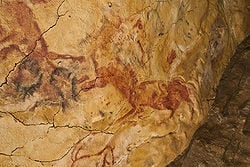
Negative images of manus prints in Altamira
Chief amidst the caves in this Earth Heritage Site is Altamira, located within the town of Santillana del Mar in Cantabria. Information technology remains one of the most important painting cycles of prehistory, originating in the Magdalenian and Solutrean periods of the Upper Paleolithic. This cave'southward artistic style represents the Franco-cantabrian schoolhouse, characterized past the realism of its figural representation.
The cavern is 270 meters (890 ft) long and consists of a series of twisting passages and chambers. Around thirteen,000 years ago a rockfall sealed the cave'south entrance, preserving its contents until a nearby tree fell and disturbed the rocks, leading to its discovery by a local hunter, Modesto Peres, in 1868. However, it was not until 1879 that the images of animals were noticed. Local amateur archaeologist, Marcelino Sanz de Sautuola, began to study the paintings together with archaeologist Juan Vilanova y Piera from the University of Madrid, resulting in a much acclaimed publication in 1880 which interpreted the paintings as paleolithic in origin. However, due to the artistic quality of the paintings, and their exceptional state of conservation, this interpretation was questioned and Sautuola was accused of forgery. Later findings of prehistoric cavern fine art in other caves somewhen led to acceptance of their work.
Farther excavations in the cave floor found artifacts of the Upper Solutrean (dated at approximately 18,500 years ago) and Lower Magdalenian (dated between sixteen,500 and 14,000 years ago) periods. Human habitation was limited to the cavern mouth but artwork was discovered on the walls throughout the cavern. Solutrean paintings include images of horses, goats, and hand prints created from the artists placing their hands on the cave wall and applying paint over them leaving a negative image of the palms. Art dated to the Magdalenian occupation also includes abstract shapes.
The cave itself is no longer open up to the public, in an endeavor to preserve the paintings which became damaged by the carbon dioxide in the damp breath of large numbers of visitors. A replica cave and museum were congenital nearby, effectively reproducing the cave and its art.
Cantabria
In addition to Altamira, the Earth Heritage Site includes 9 additional caves located in Cantabria. These are Cave of Chufín; Cave of Hornos de la Peña; Cave of El Pendo; Cave of La Garma; Cave of Covalanas; and the Complex of the Caves del Monte Castillo in Puente Viesgo which includes the following chambers: Cavern of Las Monedas, Cave of El Castillo, Cave of Las Chimeneas, and Cave of La Pasiega.
Cave of Chufín
The Cave of Chufín is located in the town of Riclones in Cantabria, in an area of the Nansa River Valley which has steep cliffs. The cave and its artwork was discovered past Manuel de Cos Borbolla, a local photographer. At the entrance of the cavern are a number of figures etched into the rock. Farther inside, in several halls are images of animals, including bison, horses, deer, and goats. The paintings date from between 16,000 and 11,500 B.C.East.
Cave of Hornos de la Peña
The Cave of Hornos de la Peña is situated on a loma near the hamlet of Tarriba in San Felices de Buelna. It was discovered in 1903. The most notable paintings are a headless bison, horse, and others at various levels in the first room and the second gear up of 35 figures are animals such as horses, bison, aurochs, goats, and other animals. The dating of the paintings indicate that they were created in the initial or middle Magdalenian menstruum.
Cavern of El Pendo
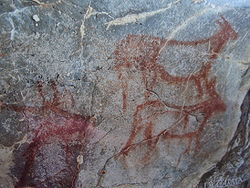
The Hinds of El Pendo Cave
The Cave of El Pendo is situated in the eye of the Camargo Valley. The cave measures upward to 40 meters (130 ft) in width and 22 meters (72 ft) in height, and dates from effectually 20,000 B.C.Due east. The 'Frieze of Paintings,' a console measuring 25 meters (82 ft) in length is visible from any point in the principal hall. This panel contains a number of figures painted in red, including several deer, a goat, a equus caballus, and diverse other symbols, all drawn using the contour technique.
Cave of La Garma
The Cave of La Garma is located on La Gama Mountain. It is divided into diverse levels: the upper hall contains man burial sites; the intermediate level has a large number of palaeontological remains, mainly bones; the lower level consists of 3, intact areas with many examples of painted fine art. They date from 28,000-thirteen,000 years ago. The paintings include a realistic black horse, goats, bison, panels with hands, equally well as many symbols painted in red.
Cavern of Covalanas
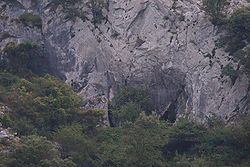
The Cavern of Covalanas was commencement discovered to accept art piece of work in 1903, though the cave was well known to the locals who knew information technology as "la cueva de las herramientas" (Tools Cavern). It is situated on the South-Western hillside of Pando mountain, very close to the village of Ramales de la Victoria.
It has 2 galleries, ane of which contains rock paintings. There are 22 red images: 18 are of deer, a stag, a horse, an aurochs, and a hybrid-type figure. At that place are as well several symbols, minor dots, and lines. The figures are distinctive for their technique, with a stippled outline made with the fingers. Given the limited use of this technique, a possible "Escuela de Ramales" (School of Ramales) has been postulated, establishing chronologically this kind of painting between xx,000 and 14,400 years ago.
Complex of the Caves del Monte Castillo
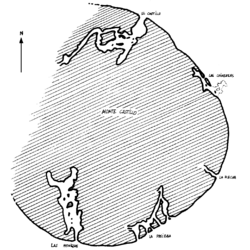
Map showing locations of the caves on Monte Castillo.
The Caves of Monte Castillo, located in the Cantabrian boondocks of Puente Viesgo, incorporate 1 of the most of import Paleolithic sites in the region. These include the caves Las Monedas, El Castillo, Las Chimeneas, and La Pasiega. This fix of caves is located along the Pas river in the Castillo mountain, squarely at the intersection of three valleys and near the coast. This is a fertile ground for agriculture, hunting, and fishing, which explains the emergence of several prehistoric settlements at that place.
The caves comprise decorations in reddish ochre in the forms of hand stencils (from equally far dorsum as 35,300 B.C.E.) and dots. I dot has been dated to 40,800 B.C.E., making it the oldest dated cave ornamentation in the world as of 2012.[one] [2]
Cave of Las Monedas
The Cavern of Las Monedas was named the Bear Cavern upon its discovery in 1952. Later on, a collection of 20 coins from the days of the Cosmic Monarchs were discovered in a sinkhole, leading to the renaming of the cave "Las Monedas" (coins). The cavern is 800 meters (two,600 ft) in length, and contains stalactites, stalagmites, columns and colored karst formations. The paintings, which date from effectually 10,000 B.C.E., are located in a small side grotto. They include creature figures (horses, reindeer, goats, bison, and a bear) as well as groups of symbols.
Cave of Las Chimeneas
The Cave of Las Chimeneas (Cave of the Chimneys) was discovered in 1953. The chimneys are limestone shafts connecting the two levels of the cave. There are several panels of macaroni-type engravings, made with the fingers on clay. There are besides black paintings, representations of animals and quadrangular symbols. Two of the figures (a deer and a symbol) are dated 13,940 and 15,070 B.C.Due east. respectively.
Cavern of El Castillo
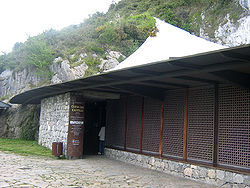
Access to the cavern, in April 2008.
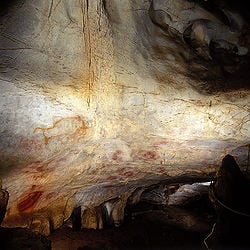
Interior of the Cave of El Castillo
Cueva de El Castillo (Cave of the Castle), was discovered in 1903 past Hermilio Alcalde del Río, the Castilian archaeologist, who was one of the pioneers in the written report of the primeval cave paintings of Cantabria. The entrance to the cave was smaller in the past, but it has been enlarged as a result of archeological excavations.
Alcalde del Río establish an all-encompassing sequence of images in a number of different chambers. After the first studies in the cave, the vestibule of Castillo was excavated by the Institut de Paleontologie Humaine at Paris, directed by Hugo Obermaier and Henri Breuil, betwixt 1910 and 1914. The cave fine art was studied at the same time, with the collaboration of Alcalde del Río and several other archaeologists.[3]
In the 1980s the excavation of the stratigraphy at El Castillo was restarted, and almost xxx archaeological layers were able to be differentiated, from the late Acheulian virtually 150,000 years ago, to the finish of the Upper Paleolithic, and even more recent prehistoric periods. This long sequence covers the transition from the Neanderthal populations of the Mousterian menstruum and the Man sapiens of the Aurignacian and later Upper Paleolithic periods.[iii]
Among the artworks are images of animals (horses, deer, bison, aurochs, and others), many superimposed, are a large number of paw stencils and disks made past bravado paint onto the wall. Some of these were recently found to date back to at least twoscore,800 years, making them the oldest known cavern art in Europe, 5,000-10,000 years older than previous examples from Chauvet Cave in France. [4] [5]
Every bit traditional methods such every bit radiocarbon dating do non work where there is no organic paint, a team of British, Spanish, and Portuguese researchers led by Alistair Pike of the University of Bristol dated the formation of tiny stalactites on top of the paintings using the radioactive decay of uranium. This gave a minimum age for the fine art. Where larger stalagmites had been painted, maximum ages were also obtained. Using this technique they establish a hand impress on 'The Panel of Hands' to appointment older than 37,300 years and nearby a scarlet disc made by a very like technique dates to older than forty,800 years:
The results demonstrate that the tradition of decorating caves extends back at least to the Early on Aurignacian catamenia, with minimum ages of 40.8 one thousand years for a red disk, 37.3 thousand years for a hand stencil, and 35.half-dozen thousand years for a claviform-like symbol. These minimum ages reveal either that cave art was a office of the cultural repertoire of the first anatomically modern humans in Europe or that possibly Neanderthals too engaged in painting caves.[1]
Cave of La Pasiega
Cueva de La Pasiega, or Cave of La Pasiega is also located in the same group of caves equally Las Monedas, Las Chimeneas, and the cave of El Castillo. La Pasiega is basically an enormous gallery, its known extent more 120 meters (390 ft), that runs more than or less parallel to the slope of the mount, opening to the surface at six different places: six small mouths, the majority obstructed, of which two tin can be accessed for inspection. The principal gallery is approximately 70 meters (230 ft) and opens to deeper secondary galleries, winding and labyrinthine, which in places broaden out to form large chambers.
The recorded remains belong mainly to the Upper Solutrean and the Lower Magdalenian ages, although older objects are also found. Throughout the cave are many 'walls' with paintings and with engraved or incised images. There are representations of equines (horses), cervids (deer, male and female) and bovines (cattle). There are besides many abstruse symbols (ideomorphs).
The scientific discovery of the La Pasiega can be credited to Wernert and Hugo Obermaier. While excavating the cave of El Castillo in 1911, they received news that the workers knew of another crenel nearby that villagers chosen "La Pasiega." The investigators soon confirmed that the cavern contained stone paintings. Later, Henri Breuil, Hugo Obermaier, and Hermilio Alcalde del Río began their systematic written report of the cave, an account of which was published in 1913.[vi]
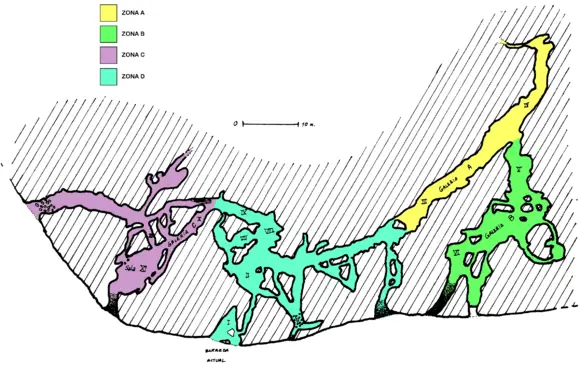
The cave is around 400 meters (i,300 ft) long with artwork in four galleries referred to as A, B, C, and D. Several hundred images of animals likewise as symbols are contained in these galleries. They date from the Solutrean to the early on Magdalenian from 19,000 B.C.East. to 14,000 B.C.E.
Gallery A contains pictures of horses, bison, aurochs, deer, reindeer, and goats painted primarily in cherry-red, only too some images are black and some are engraved. In a narrow gallery further inside are several quadrilateral signs. This gallery is dated to the Solutrean, with some figures from the early Magdalenian.
Gallery B contains cherry-red and engraved images of aurochs, bison, horses, megaloceros, goats, chamoises, and claviforms near the original entrance. These are from the early Magdalenian.
In Gallery C, figures of horses, bison, goats and others have been found painted in carmine, yellow, violet, black and fifty-fifty engraved traces. There are likewise symbols, including claviforms painted red. The period of these paintings is dated to the Solutrean and some of the Magdalenian.
Finally, Gallery D is a zone with horses, bison, deer, and quadrangular signs. Again these works are from the Solutrean to the Magdalenian.
Asturias
Five caves are located in Asturias, all situated in the Comarca de Oriente: Cave of Tito Bustillo in Ribadesella, Cavern of Candamo in Candamu, Cavern of La Covaciella in Cabrales, Cave of Llonín in Peñamellera Alta, and Cave del Pindal in Ribadedeva.
Cave of Tito Bustillo
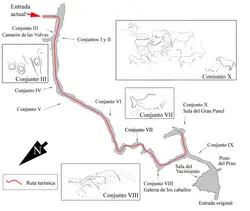
Plan of the Cave of Tito Bustillo showing locations of the paintings
The Cavern of Tito Bustillo was formerly known as Pozu´50 Ramu. It was renamed in 1968 after one of a grouping of young men, including Celestino Fernández Bustillo, rappelled downward into the cave and discovered the artwork. He died in a mountain accident a few days later on and the cave was renamed in his honor.
Prehistoric paintings cover a large portion of the Cave of Tito Bustillow, with many painted over earlier works. The dating of the fine art ranges between 22,000 and 10,000 B.C.Due east. There are 2 particularly pregnant sections: the Chamber of Vulvas which contains paintings of female forms, and the Main Panel which consists of numerous animals. The drawings of the female torso, however, are of especial interest equally they make use of the natural relief of the stone to propose the three-dimensional form of the body.
Cave of Candamo
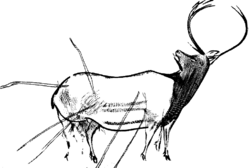
Wounded Deer in Cavern of Candamo
The Cave of Candamo is around 60 meters (200 ft) long and was discovered in 1914. The paintings are from the Solutrean period, of the Upper Palaeolithic, some xviii,000 years ago. The cave consists of several sections, get-go with the Entrance Gallery. The hall of the engravings contains the virtually important panel in the cave: the wall of the engravings, a complex collection of figures including deer, horses, bison, goats, a chamois, and other animals which are hard to identify. The techniques used are varied, mixing painting and engraving. The Camarín, at the end of this hall, contains a stalactite waterfall, on peak of which is a panel of bovids, horses, a goat, and an incomplete image of a bull. These animate being images, created by climbing the large calcite formations, ladders, or scaffolding, are visible from all points of the main fundamental sleeping room in the interior of the cave.[7] This hall also contains the Talud Stalagmite, a mural with figures of horses which precedes admission to the Batiscias gallery. In the Hall of the Ruddy Signs, we can run into signs in the class of dots, lines and other symbols which some translate as feminine and masculine.
Cave of La Covaciella
The cavern of La Covaciella is located in the surface area known as Las Estazadas in Cabrales (Asturias). It was discovered in 1994 completely past risk when several of the local inhabitants entered the grotto through an opening which had been made during route construction.
La Covaciella is formed by a gallery 40 meters (130 ft) long which opens out onto a slap-up chamber. Its interior space was sealed when the original entrance was blocked due to natural causes. Although closed to the public, the prehistoric art in this cave can exist enjoyed at the visitor centre in Casa Bárcena in the village of Carreña de Cabrales. The paintings appointment dorsum more than 14,000 years.
Cavern of Llonín
Likewise known as "La Concha de la Cueva," the Cave of Llonín is located in a narrow valley on the banks of the Cares River. The cavern runs for 700 metres and contains around xxx prehistoric engravings and paintings. These include images of deer, reindeer horns, goats, snakes, and a bison.
Cueva del Pindal
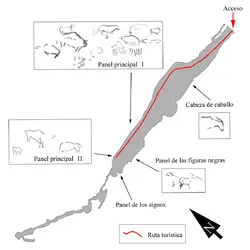
Plan of Cueva del Pindal showing locations of the paintings
Cueva del Pindal is located near the town of Pimiango in Asturias, near the border of Cantabria. The cave is 300 meters (980 ft) long and has numerous cavern paintings, mostly on the right-hand wall. The cavern paintings were discovered in 1908. They include several bison and horses, with a duo comprising a bison and a horse equally the main motif. There are also other creatures represented, including a fish and a mammoth, too equally symbols, dots, and lines. Both ruby and black colors were used. Their estimated age is betwixt 13,000 and eighteen,000 years.
Basque Land
3 caves are located in the Basque Land.
Cave of Altxerri
Located on the eastern slopes of Beobategaña Mountain, Altxerri Cave contains rock engravings and paintings from the Magdalenian period, dating between 13,000 and 12,000 B.C.E. The engravings are well preserved. The paintings, however, have deteriorated on account of the damp, leading to the cave existence closed to the public.
Cavern of Ekain
The Cave of Ekain was already known to the people in the village of Sastarrain in Guipscoa, when the cave fine art was discovered in June 1969. The accessible part of the cave was pocket-sized, merely to the right of the archway some boulders had blocked a pocket-size opening. When these boulders were moved bated, a larger passage was revealed, that runs for 150 meters (490 ft) and contains numerous paintings and engravings.[8] There is a large console total of paintings of horses. In add-on to horses, at that place are besides other animals such as bison, deer, and goats.
Cave of Santimamiñe
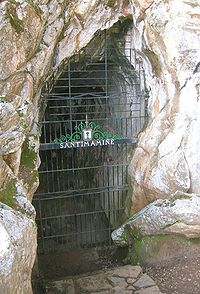
The Santimamiñe cave, is located in Kortezubi, Biscay, Basque Country on the right bank of the River Urdaibai and on the foothill of Ereñozar Mountain. The cave paintings were discovered in 1916 when some local boys explored them. It is all-time known for its mural paintings of the Magdalenian flow, depicting bison, horses, goats, and deer.
It is ane of the nearly important archaeological sites of the Basque Country, including a nearly complete sequence from the Centre Paleolithic to the Fe Age.
Notes
- ↑ 1.0 1.one Alistair W.G. Pike et al., "U-Serial Dating of Paleolithic Art in 11 Caves in Espana" Science, 336(6087) (June fifteen, 2012): 1409-1413. Retrieved October 10, 2013.
- ↑ Michael Marshall, "Oldest confirmed cavern art is a single crimson dot" New Scientist (June 20, 2012): x-11. Retrieved October 10, 2013.
- ↑ 3.0 3.1 César González Sainz and Roberto Cacho Toca, Castillo Cave, Cantabria. Retrieved Oct ten, 2013.
- ↑ Jean Clottes, Chauvet Cave: The Art of Earliest Times (University of Utah Press, 2003, ISBN 978-0874807585).
- ↑ Jonathan Amos, Red dot becomes 'oldest cavern art' BBC News, June 14, 2012. Retrieved October 10, 2013.
- ↑ Henri Breuil, Hugo Obermaier, and Hermilio Alcalde del Río, La Pasiega à Puente Viesgo (Monaco: Chêne, 1913).
- ↑ César González Sainz and Roberto Cacho Toca, Peña de Candamo Cavern, Asturias Retrieved Oct 10, 2013.
- ↑ César González Sainz and Roberto Cacho Toca, Ekain Cave, Guipscoa, Basque Country Retrieved October x, 2013.
References
ISBN links support NWE through referral fees
- Bahn, Paul G. Cave Art: A Guide to the Decorated Water ice Age Caves of Europe. Frances Lincoln, 2012. ISBN 978-0711232570
- Breuil, Henri, Hugo Obermaier, and Hermilio Alcalde del Río. La Pasiega à Puente Viesgo. Monaco: Chêne, 1913. OCLC 636669141
- Clottes, Jean. Chauvet Cave: The Art of Primeval Times. Academy of Utah Press, 2003. ISBN 978-0874807585
- Clottes, Jean. Cavern Art. Phaidon Press, 2010. ISBN 978-0714857237
- Lawson, Andrew J. Painted Caves: Palaeolithic Rock Art in Western Europe. Oxford Academy Printing, 2012. ISBN 978-0199698226
External links
All links retrieved January xi, 2019.
- Cave of Altamira and Paleolithic Cave Art of Northern Spain UNESCO World Heritage List
- Introduction to Cave Fine art in the Iberian Peninsula
- Caves and Rock Shelters on the Due north coast of Spain
- El Chufín Cave
- The Fine art of Paleolithic Hunters in the N of Spain
- Hornos de la Peña Cave
- El Pendo Cavern
- La Garma Cave
- El Pindal Cave
- Tito Bustillo Cave
- Peña de Candamo Cave
- Cueva de la Peña de Candamo
- Las Monedas Cave
- Las Chimeneas Cave
- Virtual bout of the Covaciella cave
- Llonín Cave
- Altxerri Caves
- Ekain Cave
- Santimamiñe Cave
- Video: Paleolithic Cave Arts in Northern Spain: El Castillo Cave
- Arte Paleolítico - Cueva de La Pasiega
- La Pasiega Gallery A,B and its Rock Art List
- La Pasiega Gallery C and its Rock Fine art List
Source: https://www.newworldencyclopedia.org/entry/Paleolithic_Cave_Art_of_Northern_Spain
0 Response to "Paleolithic Cave Art Are Found in What Spanish Cave"
Post a Comment